
|
Sale 24
Manuscript and Collectibles Auction
| Lot |
Photo |
Description |
Realized |
Lot 625 |
 |
14 Inch Long Stingray and Fish Fossil. Stingrays (Heliobatis radians) are among the rarest and most beautiful of all the Green River, Wyoming fossils. These rare stingrays were cut off from the inland sea as it started draining in the late Cretacious period. Stingrays are so rare in the fossil record because, just like sharks, they are mostly cartilage. This museum quality, 14 inch long, 50 million year old stingray is nearly complete, with details rarely seen on such fossils. The very tiny bones of the "wing," the eyes, stingers, and even the male sex organs, called claspers, are very clear. The claspers, also seen on sharks, are 1 inch conical-shaped organs pointing downward right above the tail. As an extra bonus, there is also a 2¾ inch long Knightia fish above the stingray. For the collector desiring the finest quality stingray. Weight is 17 pounds.
Estimated Value $1,850 - 2,250.
View details and enlarged photo
| Realized
$2,760 |
Lot 626 |
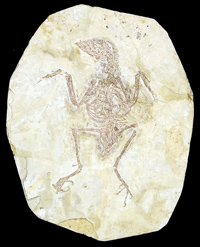 |
140 Million Year Old Bird Fossil From China. In the last several years, the most spectacular dinosaur fossil finds of the century have come out of China, particularly the Liaoning Province. Along with the feathered dinosaurs are also found some of the oldest birds in the fossil records. This small 5¼ inch primitive bird, Liaoxiornis delicatus, dates from the late Jurassic period and only Archaeopterix from Germany is older at 150 million years.
This remarkable, virtually complete bird is remarkable in the details of its preservation. Birds have light, delicate bones that rarely fossilize at all. Due to an enormous volcanic eruption 140 million years ago, this bird was killed by the gases and quickly buried in volcanic ash, thus preserving it intact. There are dark feather impressions at the back of the head and neck, as well as beneath the right wing and at the bottom of its body. The all-important features that identify it as one of the most primitive birds are present as well: two small sharp teeth at the end of its beak, as well as claws at the ends of its wings. Displayed in a 9 x 7 inch Ryker mount to preserve the delicate, soft stone matrix of the compressed volcanic ash layer. A most important and impressive fossil. Weight is 1.1 pounds.
Estimated Value $1,850 - 2,750.
View details and enlarged photo
| Realized
$2,300 |
Lot 627 |
 |
16 Inch Triceratops Lower Jaw With Teeth. Triceratops, with its two long brow horns, is one of the most famous and popular dinosaurs. Although most of the teeth in this 16 inch lower jaw are broken, there is one large, perfect tooth present, along with many broken teeth. Triceratops could replace its broken and worn teeth with a constant supply of new teeth growing behind the top outside teeth. With complete skulls selling for over $100,000, this is an excellent opportunity to purchase an expertly-repaired, lower-jaw section with teeth at a fraction of that cost. This impressive fossil is 65-70 million years old, from Montana. Weight is 6 pounds.
Estimated Value $1,500 - 2,000.
View details and enlarged photo
| Unsold |
Lot 628 |
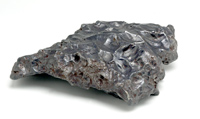 |
20½ Ll. Sikhote-Alin Iron-Nickel Meteorite From Siberia. A 20½ pound Sikhote-Alin meteorite is practically unheard of. Most recovered pieces from the very remote area of Siberia are very small, only weighing in at a few ounces. This is due to the tremendous explosion that took place several miles up in the atmosphere on February 12, 1947 over the Sikhote-Alin mountains of Siberia.
This most impressive meteorite measures 9½ x 8 x 3 inches and is covered by medium-sized thumb prints (regmaglypts) on all sides, as well as the regular gun-metal color fusion crust that is a signature of well-preserved Sikhote-Alin meteorites. This specimen is much larger than the Sikhote-Alin specimens found in most museums, including the Smithsonian and the American Museum of Natural History. This large meteorite would be the highlight of almost any meteorite collection. Also included is one of the 1957 Russian Sikhote-Alin stamps that shows a painting of the observed explosion and smoke trail of this enormous meteorite. The smoke trail remained in the sky the entire day. Weight is 22 pounds.
Estimated Value $3,500 - 4,500.
View details and enlarged photo
| Realized
$4,600 |
Lot 629 |
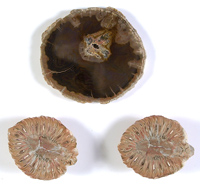 |
210 Million Year Old Polished Pine Cone. These detailed colorful pine cones come from the Araucaria tree (Monkey Puzzle Tree) which is the most primitive of conifers and was a favorite food of sauropod dinosaurs. This large 2¾ inch pine cone from Patagonia, Argentina, over 210 million years old, has been cut in half and polished to show the strikingly beautiful interior, which is tan and orange with intricate details showing the core and small seeds. Also included is a polished 4 inch tree section from this extinct species of Araucaria tree found near the southern-most tip of South America. Weight is 1 pound.
Estimated Value $650 - 900.
View details and enlarged photo
| Unsold |
Lot 630 |
 |
3 Inch Dinosaur Foot Claw - Archaeornithomimus. Dinosaur claws are much much rarer than dinosaur teeth, since dinosaurs replaced their teeth but not their claws. Ornithomimus' name means "bird mimic." This 3 inch long foot claw is the largest of the 3 claws on each foot. Ornithomimus dinos were very fast running dinos, somewhat similar to modern flightless birds with long tails. All ornithomimids had no teeth and ate small vertebrates, insects, and fruits. Displayed in Ryker case. Weight with case is 6 ounces.
Estimated Value $500 - 1,000.
View details and enlarged photo
| Unsold |
Lot 631 |
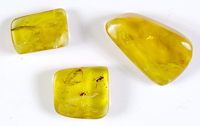 |
3 Piece Collection Of Baltic Amber. At 50-55 million years old, Baltic amber from the Samland Peninsula in Russia is some of the oldest collectible amber available. This collection contains premium examples of a spider and several different types of midges and flies. All of the amber nuggets are clear and with golder amber color.
(1) A somewhat large 3/8 inch spider clearly defined in a milky covering that formed from an emulsion of micro bubbles caused by decomposition. All 8 legs and 2 stalked eyes are clearly visible. Spiders are uncommonly preserved in amber. Amber nugget is 1¼ x ¾ inch.
(2) Museum-quality fly (an enlarged full-color photograph included) with remarkable microscopic detail of head, eyes, wings and even the small hairs protruding from the head in a clear ¾ ½ inch amber nugget.
(3) 5 different types of flies and midges from small to medium size all nicely detailed in a ¾ x ½ inch amber nugget. The three amber nuggets and color photograph are mounted in an 8½ x 6½ inch Ryker box for excellent display and easy access. Total weight with box is 10 ounces.
Estimated Value $250 - 400.
View details and enlarged photo
| Realized
$316 |
Lot 632 |
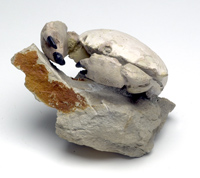 |
40 Million Year Old Stone Crab. Verona, Italy is famous not only for its gentlemen, but also for these spectacular, three-dimensional crabs. This large 5 x 3½ inch stone crab (Harpactocarcinus punctulatus) is virtually complete, including a complete carapace with two sharp side spikes, two eye holes, one with delicate shell covering still intact, and two huge claws, 3½ and 3 inches in length, complete with tips. Set in its natural limestone matrix, this crab looks as if it is ready to climb back into the ocean. Fron a site near Verona, Italy, now closed to collectors. The only available specimens come from existing collections. Weight is 2½ pounds.
Estimated Value $650 - 900.
View details and enlarged photo
| Unsold |
Lot 633 |
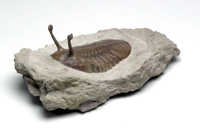 |
450 Million Year Old Trilobite With 1 Inch Long Eyestalks. Looking like some strange kind of alien life form, this amazing 3¼ inch trilobite had its eyes attached to 1 inch long stalks that protruded above the seafloor where it buried itself to hunt small prey and to protect itself from predators. This stunning brown trilobite, Neoasaphus kowalewski, looks alive, as if it were still crawling over the creamy smooth textured sandstone matrix. If you could own only one trilobite, this weird trilobite, found near St. Petersburg, Russia, would certainly make an excellent choice. Weight is approximately 2 pounds.
Estimated Value $375 - 500.
View details and enlarged photo
| Unsold |
Lot 634 |
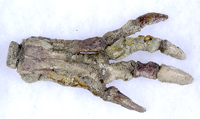 |
5 Inch Dinosaur Hand Claw - Psittacosaurus. This 5 inch hand claw belongs to a very important dinosaur, Psittacosaurus (translates to "parrot-beaked reptile"). It is the earliest ancestor of famous horned dinosaurs such as Triceratops. One specimen of Psittacosaurus even had weird barbs on its tail, somewhat like a porcupine. Psittacosaurus was a small dinosaur, only 4 to 5 feet long, that walked bipedally. This complete hand has had all the bones and claws attached to form a complete hand. The bones are a tan color and the claws are nearly complete. In life these claws would have been covered in keratin, the same substance that forms our fingernails. The inner claw was longer and sharper than the other three and may have been used for defense. Found near Beipiao city in Liaoning Province of northern China, this 130-135 million year old dinosaur is more than 60 million years older than its famous relative Triceratops. Weight is 12 ounces.
Estimated Value $850 - 1,250.
View details and enlarged photo
| Realized
$748 |
Lot 635 |
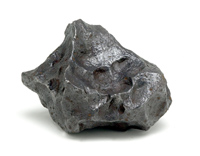 |
8¼ Lb. New Campo del Cielo Iron-Nickel Meteorite. This 5 x 5 inch, 8¼ lb. iron-nickel meteorite has an aesthetically sculpted shape with many small thumbprints, called regmaglypts. There is also one very large regmaglypt on the bottom side. The best specimens of Campos, known as "new" Campos have been found higher up the mountain from the older ones. These new Campos are much more desirable due to their sculpted shape and regmaglypts. Campo del Cielo translates as "Valley of the Sky" and fell 4,000 years ago in Argentina. Spanish explorers wrote about these meteorites in 1576. This is an opportunity to purchase a large and pleasing iron-nickel meteorite at a modest price. Weight is 8½ pounds.
Estimated Value $1,000 - 1,750.
View details and enlarged photo
| Unsold |
Lot 636 |
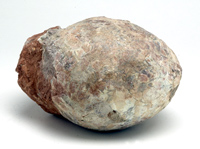 |
80 Million Year Old Duckbilled Dinosaur Eggs. All fossils from dinosaurs are in great demand and dinosaur eggs that are unhatched and complete are fantastic values at this time. Before 1923 there were only a couple of dinosaur eggs known and some paleontologists even doubted that dinos laid eggs. This theory was finally shown to be in error when Roy Chapman discovered dozens of dinosaur eggs in nests in the Gobi Desert on Mongolia. This was the paleontological news event of the century and one egg was auctioned off at the unbelievable price of $10,000; in 1923, $10,000 would have purchased more than 40 automobiles.
This complete unhatched Hadrosaur (duckbilled) dinosaur egg is 70-80 million years old and measures 7 inches long and 6½ inches wide. It was found by farmers from the Xixia, Henan Province of China. The exact species of dinosaur cannot be determined from just an egg, but this shape of egg has been determined to be from a duckbilled dinosaur from duckbilled dino bones found in the area of the nests of eggs. Such a Hadrosaur duckbilled dinosaur is Shantungosaurus, which has been found in the same area as the eggs and was one of the largest Hadrosaurs at more than 50 feet long. Duckbills herded together and nested in great numbers (100-200 large animals). Weight is 7 pounds.
Estimated Value $400 - 600.
View details and enlarged photo
| Realized
$460 |
Lot 637 |
 |
9 Inch Long Ammonite With Preserved Mother-of-Pearl. Most Ammonites have a coiled spiral shape. The name "ammonite" comes from the Egyptian god Ammon, who is depicted with a coiled ram's horn. This 9 inch long ammonite from Russia (Ancyloceras matheronianum) is over 100 million years old and has an unusual, mostly uncoiled, shape called Heteromorphic. Heteromorphic ammonites start out with a tight curl and, for some unknown reason, begin to uncoil as they grow longer. This large and strikingly beautiful ammonite is nearly complete, with just the smallest inner curls missing, and the original white mother-of-pearl has fossilized to an iridiscent brown and tan with splases of white still present. The museum-quality ammonite is neatly contrasted against a black slate matrix. Weight is 6½ pounds.
Estimated Value $900 - 1,500.
View details and enlarged photo
| Unsold |
Lot 638 |
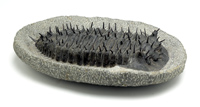 |
A Choice and Rare Large, Spiked Trilobite. Circa 380 million years old. Everyone knows trilobites as small, 1 or 2 inch black bugs, but some were much larger and much more interesting. This rare trilobite--Burmeisterella, from Morocco--is not represented in any museum. It is almost monumental at 10 inches long and nearly 6 inches wide, and strange with 2 stalked eyes and fearsome-looking with its entire body covered with sharp spikes to prevent predation. Similar specimens have sold for more than $3,000 at auction. This one very well preserved with most of its spicules present. Naturally, since small stone elements like these are delicate, a number have been re-attached. Weight is 12 pounds. Very impressive.
Estimated Value $850 - 1,650.
View details and enlarged photo
| Unsold |
Lot 639 |
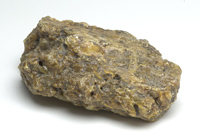 |
A Good-sized Nodule of Amber. Columbia. The almost slab-shaped chunk, a deeper honey-yellow color, and rich with inclusions from wood, debris, and bugs. Zones of transparent material mixed with translucent and opaque. Polishing a "window" here and there would make it easier to assess what lurks within. Roughly 6-1/2" x 4" x 2". Weight, almost 1 pound.
Estimated Value $375 - 550.
View details and enlarged photo
| Unsold |
Lot 640 |
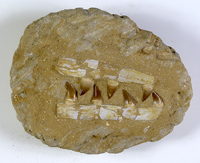 |
A One Half Foot-Long Mosasaur Jaw Section, 90-100 Million years old. Mosasaurs were the top predators of the Cretaceous seas 90-100 million years ago. They ate sharks for breakfast. Found in the Sahara desert of Morocco, this attractive jaw section is centered in a 10" x 9" sandstone matrix. Single teeth are fairly common, but jaw segments with teeth attached are rarely encountered. There is excellent color contrast between the off white bone, brown sandstone matrix and darker brown teeth. The teeth are still sharp with excellent enamel and roots. In fact, the bone almost looks as if it has acquired a slight degree of white opalization as it mineralized. A fine display object. Weight is 9 pounds.
Estimated Value $350 - 450.
View details and enlarged photo
| Unsold |
Lot 641 |
 |
Brilliant Quartz Cluster From Brazil. Consists of one gigantic squat crystal to which are attached clusters of smaller crystals at the base. The smaller crystals are arranged, by nature, in such a way that they appear to be climbing the sides of the large crystal, making for an exquisite display piece, 8 in. high, about 6 in. wide at widest point. The large crystal is about 5 in. wide and has shimmering, glass-like inclusions that create an almost mystic effect. The sort of specimen that would be deemed perfect for a crystal ball! Weight is 10½ pounds.
Estimated Value $200 - 300.
View details and enlarged photo
| Unsold |
Lot 642 |
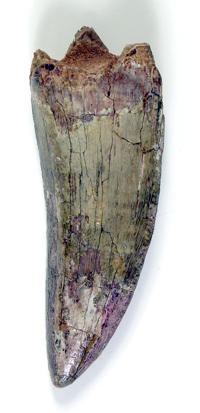 |
Carcharodontosaurus saharicus Tooth, 4¼ Inches Long. Size does matter in dinosaur teeth. Even though Carcharodontosaurus saharicus is even larger than a T-Rex, most of the teeth found are only 1½-2½ inches long. This magnificent brown to reddish-brown tooth has most of its enamel present with only slight cracks, which are nearly always present. Its sharp serrations are nearly complete on both sides of the tooth. This shed tooth would be more than one foot long if its root were still attached. Carcharondontosaurus teeth are found in the Sahara desert, Morocco and are older than T-Rex at 70-80 million years old. This tooth is housed in a 5 x 6 inch Ryker mount case. Weight with case is 8½ ounces.
Estimated Value $1,250 - 1,750.
View details and enlarged photo
| Realized
$978 |
Lot 643 |
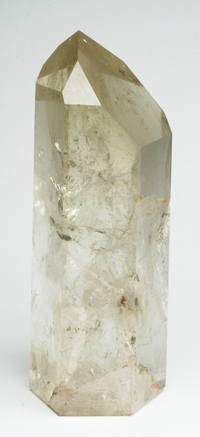 |
Colossal Single Quartz Crystal. 11¼ in. high by about 4½ in. wide at widest point. Cut smooth on bottom so that it stands perfectly vertical as a sensational display piece. Weights 12½ pounds. Exterior clarity of this specimen is such that its inner composition can be seen as in a prism, showing how it was formed many millions of years ago. Of particular interest are the inclusions, which include traces of pinkish-red copper and a fern sprig. The presence of ferns in quartz specimens is of extreme rarity, far more so than insects in amber. From Brazil.
Estimated Value $300 - 400.
View details and enlarged photo
| Realized
$265 |
Lot 644 |
 |
Complete Fourth Toe of a Theropod Dinosdaur. Dromaeosaurus albertensis was a Coelurosaur, a meat-eating dinosaur believed to be one of the ancestors of birds. It hunted in packs and was about eight feet long with sharp teeth and a large killing claw. It lived 70 million years ago in the Judith River Valley near Alberta, Canada. This museum quality, complete fourth toe (only the fourth toe had four phalanges) consists of all four phalanges, up to 1¼ inches long, as well as a ½ inch claw. The claw is complete except for a slightly weathered tip. All five bones are grayish-brown in color, with even minute details present. Housed in a Ryker mount for dramatic display. Weight with case is 6 ounces.
Estimated Value $600 - 800.
View details and enlarged photo
| Unsold |
Lot 645 |
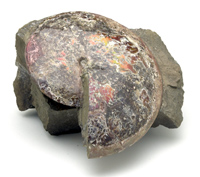 |
Complete Giant Ammonite, Over 90 Million Years Old. A 9½ inch diameter example of Sphenodiscus lenticularis from the Cretaceous period, over 90 million years ago. Ammonites are related to the Chamber Nautilus but became extinct 65 million years ago with the demise of the dinosaurs. This beautiful example still has some of its original mother-of-pearl, which has toned from brown to irridescent red (red mother-of-pearl is now a gemstone called ammolite). Strength sutures show where the mother-of-pearl has worn off. Most ammonites are only 2 to 3 inches in diameter. Very large ammonites such as this one are highly valued by collectors. This one was found in Montana and sits upright against a solid stone matrix, making for an excellent display or even a book-end. Weight is 13 pounds.
Estimated Value $350 - 600.
View details and enlarged photo
| Unsold |
Lot 646 |
 |
Complete Juvenile Mammoth Tusk. This mammoth tusk (Mammuthus primigenius) is 32 inches long x 3 inches wide, and has been polished, displaying patterns of cream, tan and shades of brown. The tusk is virtually intact, without the usual cracks and spintering. Fossil ivory, such as this 15,000-20,000 year old specimen, is the only ivory that can be legally traded. Broken pieces of mammoth ivory are carved into sculptured figures and scrimshaw. Complete tusks are in extremely high demand since most ivory found is fractured and in pieces. Found in the Dominion Creek area, Dawson City, Yukon Territory, Canada. A rare opportunity to acquire a visually stunning and highly displayable fossil. Weight is 6 pounds.
Estimated Value $1,750 - 2,750.
View details and enlarged photo
| Realized
$2,013 |
Lot 647 |
 |
Complete Mammoth Tooth With Roots, Set In A Partial Mandible. This complete, near perfect mammoth tooth is 7 x 5½ inches and is still set in a portion of the lower jaw, mandible. Woolly mammoths roamed over the northern hemisphere and became extinct less than 20,000 years ago. This spectacular tooth, with its roots intact and exposed in the inner jaw, is more than 80,000 years old and was found in a rare area for fossils, San Fluss, Poland. The appealing brown bone is in near perfect condition, showing even the minute internal structure. The back of the mandible has been cut away to reveal the detail of the complete roots. This is a museum-quality specimen. Weight is 7 pounds.
Estimated Value $500 - 850.
View details and enlarged photo
| Unsold |
Lot 648 |
 |
Duckbilled Dinosaur Lower Jaw Section, 10 Inches Long. Dinosaur teeth are rare, but a partial lower jaw section with more than 35 teeth can usually only be seen in a museum. This 10-inch jaw segment is from the famous duckbilled dinosaur, Edmontosaurus. It was extracted from the 70 million year old Oldman Formation in the Red Deer River Valley of Alberta, Canada. The jaw is a rich dark brown color. The teeth, which measure up to 1 inch, are an even darker brown. Unlike mammals, dinosaurs continually replaced their teeth throughout their lives. Smaller teeth can be seen growing beneath the larger surface teeth. Jaws with teeth are rarely available because they are needed to assemble more complete displays by museums. This specimen is an outstanding display and study fossil. Weight is 4 pounds.
Estimated Value $1,500 - 2,500.
View details and enlarged photo
| Unsold |
Lot 649 |
 |
Duckbilled Dinosaur, Edmontosaurus Vertebrae. This large, 10½ x 4½ inch, well preserved, dorsal vertebrae is nearly complete. Missing only the tip on the right neural spine. The delicate neural spines are usually missing. The bone is a chocolate brown color, displaying the hollow "honeycomb" bone structure where exposed. Dinosaur bones were somewhat hollow inside to reduce their weight. This affordable, identifiable dino bone is 70 million years old, from the Hell Creek Formation in Wyoming. Edmontosaurus was probably T-Rex's favorite food as they travelled in herds through T-Rex territory. Weight is 5½ pounds.
Estimated Value $350 - 450.
View details and enlarged photo
| Realized
$518 |
Lot 650 |
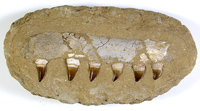 |
Foot-Long Mosasaur Jaw Section, 90-100 Million Years Old. Mosasaurs were the top predators of the cretaceous seas 90-100 million years ago. They ate sharks for breakfast. Some of these large marine reptiles grew to over 60 feet in length. They were not dinosaurs, as no dinosaurs swam in the ocean, but are distant relatives of the present Komodo dragon. Found in the Sahara desert of Morocco, this impressive foot-long, jaw section is centered in a 17 x 9 sandstone matrix. Single teeth are fairly common, but jaw segments with teeth attached are rarely encountered. There is excellent color contrast with light brown and gray bone, brown sandstone matrix and darker brown teeth. The teeth are still sharp with excellent enamel and roots. This is a most impressive fossil from the T-Rex of the cretaceous ocean. Weight is 17½ pounds.
Estimated Value $400 - 700.
View details and enlarged photo
| Unsold |
Lot 651 |
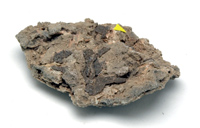 |
Fossilized Skin Of A Sauropod Dinosaur Embryo. Found in Auca Manuevo, Argentina (Patagonia) in 1997, a few of the crushed eggs of one of the last types of Sauropod dinosaurs, known as Titanosaurs, contained the first fossils of embryonic dinosaur skin. The 5 to 6 in. round eggs were buried in a flood 80 million years ago and flattened by compaction. In just a few of the eggs recovered, some embryonic bones and skin were found on the lower part of the crushed eggs. This remarkable 3 x 2½ in. egg fragment contains a few pieces of bone and a ½ in. section of rare dino embryonic skin attached to a bone fragment. This skin fossil is not an impression left by the skin in the surrounding mud, but is an actual 3-D replication of the skin itself. The tiny scales do not overlap as do the scales in reptiles, but are arranged in a rosette pattern in which 8 smaller scales surround a larger center scale. The area of dino skin is identified by a white tag on this specimen which has much brown eggshell on the bottom side with its ornamented pattern and broken pieces of eggshell in the interior, along with the skin and bone fragments.
Only a few dozen eggs contained embryonic skin, and most of these are in museums. The Auca Manuevo site, made famous by the Discovery Channel's Dinosaur World, has been declared a fossil preserve, and no more specimens will be available.
Estimated Value $750 - 1,500.
View details and enlarged photo
| Unsold |
Lot 652 |
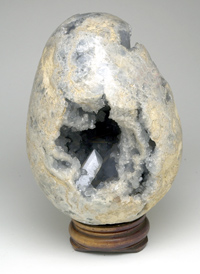 |
Giant Celestine Egg From Madagascar. One of the legendary favorites, not only of mineral enthusiasts but of fans of the odd and bizarre, celestine eggs have had their place in royal European cabinets since the early days of exploration. Seldom are they found in such prodigious size as this specimen. Average weight of celestine eggs is from about 4 to 8 pounds; this one is a whopping 37 pounds! The breccia crust is punctuated throughout its gnarly surface with peeks of shimmering celestine crystal, while large apertures at strategic points allow one to look deep inside, into a wonderland of variformed large and small crystal bunches arrayed in patterns that dazzle the eye. About 11½ in. in height and 7½ in. in diameter at the widest point. With display stand.
Estimated Value $350 - 450.
View details and enlarged photo
| Realized
$253 |
Lot 653 |
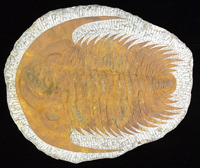 |
Giant Trilobite Paradoxites -- Over 500 Million Years Old. Trilobites are an extinct group of Arthropods related to still existing horseshoe crabs. Most are only an inch or two in length. Large trilobites such as this 11 x 9 inch giant are rarely found anywhere in the world. Only in the Atlas Mountains of Morocco are such gigantic trilobites found. This excellent specimen is complete from the eyes to the very small tail (pygidium). It is preserved just as it died on a warm ocean bottom more than 500 million years ago. It has a wonderful contrasting reddish-brown color (high iron content) on a light tan matrix. These impressive trilobites are in high demand from collectors because of their great size. Weight is 7 pounds.
Estimated Value $450 - 650.
View details and enlarged photo
| Unsold |
Lot 654 |
 |
Group Of 4 Trilobites With Eyestalks. Some of the most life-like and spectacular of trilobites come from the 450 million year old Wolchow River Basin southwest of St. Petersburg, Russia. These incredibly detailed trilobites are usually found as individuals but rarely as a group. This group of 4 eye-stalked trilobites (Neoasaphus kuthkovi) range in size from 3 inches to 4 inches in length. These highly unusual trilobites buried themselves in the sandy sea bottom with only their eyes exposed, protecting themselves from predators and enabling them to ambush small prey.
What is even more unusual is the preservation of one of these rare trilobites in an upside down position, exposing its thin, sharp mouth, known as a hypostome. The hypostome is carved out in high relief. This family of 4 trilobites is aesthetically displayed on the natural limestone base measuring 16 x 9 inches and including a 1¼ inch round ball echinodum, a relative of modern sea urchins related to star fish with plates of five-fold symmetry making up its body. A museum-quality display of light brown trilobites. Total weight is 13 pounds.
Estimated Value $950 - 1,500.
View details and enlarged photo
| Unsold |
Lot 655 |
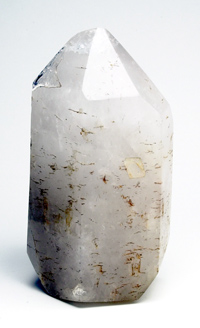 |
Huge Crystal of Milky Quartz, Ribbed With Copper Inclusions. Massive single crystal, 11 in. high x 6 in. wide at the widest point, weighing an incredible 17½ pounds! Rich milky color that looks almost good enough to sink a spoon into. Interior surface is gorgeously banded with fissures that have (in the majority) entrapped highlights of raw copper. This rare specimen was collected in Madagascar. A very unusual, exotic treasure for the mineral collector.
Estimated Value $350 - 450.
View details and enlarged photo
| Unsold |
Lot 656 |
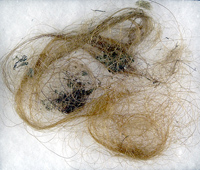 |
Large Patch of Woolly Mammoth Hair. This exceedingly rare specimen of mammoth hair consists of both types of hair present, the long reddish-brown outer hair, as well as the soft tan inner hair. There is over ten times as much hair in this lot as is normally offered. More than 30,000 years old, this remarkable specimen comes from the frozen carcass of one of only 12 Woolly Mammoths found frozen in the permafrost of the Indigirka Basin in Siberia. This specimen was part of the collection owned by Dr. Gennady Baryshnikov, head of the History of Faunas Department, Zoological Institute, USSR Academy of Sciences in Leningrad. Weight is 6 ounces.
Estimated Value $500 - 800.
View details and enlarged photo
| Realized
$288 |
Lot 657 |
 |
Large Polished Block of Amber. Columbia. A substantial chunk, of fine corn syrup yellow color, with all the usual bubbles and inclusions from wood, debris, and bugs. On the smoother more expansive face, near to the surface, is a perfect and sizable termite. But also there are many zones of virtually bubble free, gem grade material. An equal opportunity artifact -- good as is, or can be cut up for profit. Roughly 8" x 6" x 5-1/2". Weight, about 4 pounds.
Estimated Value $1,250 - 1,500.
View details and enlarged photo
| Unsold |
Lot 658 |
 |
17 Inch Snail, 50 Million Years Old. The second most popular item from Champagne, France, is this 50 million year old Gastropod, Campanile giganteum. The spiral construction and large knobs are the defining characteristics of this most impressive fossil gastropod. It is more than twice as long as its closest living relative, the Bell Clapper of Australia, which grows to only 7 or 8 inches in length. There are several other seashells in the 18 x 12 inch natural limestone matrix. This huge gastropod and natural matrix make for an unbelievably impressive display with a free-standing base. Weight is 37 pounds.
Estimated Value $750 - 1,500.
View details and enlarged photo
| Realized
$575 |
Lot 659 |
 |
Lobster-Like, 150 Million Year Old Crustacean. This 6½ inch lobster-like crustacean, known as Mecochirus longimanatus, is unusual in that it has an unbelievably long pair of front walking legs with pincers. They are 4 inches long, over half the total length of this crustacean. Mecochirus used these legs to raise itself out of the sand and swing its body backwards. Housed in a Ryker mount for display. This fabulous specimen is from the Solnhofen, Germany fossil bed. Solnhofen is famous as the site of the first bird, Archaeopteryx, from the Jurassic period. Weight with case is 4 pounds 6 ounces.
Estimated Value $500 - 700.
View details and enlarged photo
| Realized
$403 |
Lot 660 |
 |
Museum-Quality Sinohydrosaurus, A 150 Million Year Old Aquatic Reptile. This new and unusual reptile was found in the same formation as the famous feathered dinosaurs. This complete adult 18 inch specimen is absolutely amazing, with every bone a distinct brown color on a light tan matrix. The skull is excellent and all four feet are present, complete with sharp, tiny claws. Even the very end of the tail is present, but disarticulated. The museum-quality fossil is mounted in a custom 36 x 20 inch, black and red wooden frame on a black felt background. Sinohydrosaurus is still not identified. It may be related to Nothosaurs such as Keichosaurus or Lepidosaurs, of which the Komodo Dragon is a member. The incredible detail of this fossil was due to its being quickly buried in a massive volcanic eruption 130 million years ago in China. Weight is 25 pounds.
Estimated Value $1,500 - 2,500.
View details and enlarged photo
| Realized
$1,093 |
Lot 661 |
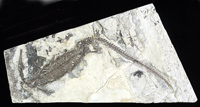 |
Near Complete Mesosaurus Skeleton - 260 Million Years Old. This excellent fossil of a 25 inch long marine reptile is both visually impressive, being nearly complete, and important for the information imparted by its geographical distribution. First of all, this small aquatic reptile was the very first known reptile to return to the sea 260 million years ago, shortly after evolving from amphibians. But even more importantly, it helps prove the theory of continental drift, as it is found only on the western part of
South Africa and the eastern part of South America. This proves that the two continents had to be connected 260 million years ago since this small reptile could not have swum across the Atlantic Ocean.
This near complete skeleton of Mesosaurus is from the Irati Formation of Brazil. The attractive brown bone is most notable in showing detail of the crocodile-like skull, including several small sharp teeth, with each tooth in its own socket. Also, the tail is complete except for the very end of the tip, which is rare in this type of fossil. Only the four limbs and feet are either missing or disarticulated. This impressive pre-dinosaur reptile is 25 inches long in its natural 20 x 10 inch limestone matrix. Weight is 12 pounds.
Estimated Value $1,500 - 2,200.
View details and enlarged photo
| Unsold |
Lot 662 |
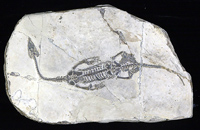 |
Near Complete Mini "Loch Ness" Monster, Keichousaurus. Keichousaurus is a 240 million year old reptile from Goiznou Province, China. This beautiful specimen is 9 inches long, with its head twisted around into its death position. It is nearly complete, down to the small claws. All four limbs are present and intact, which is rarely the case. It is a dramatic black color on a light tan stone matrix. Keichousaurus was the ancestor of the long-necked Plesiosaurus, which the Loch Ness monster is rumored to be. Keichousaurus had a long, flexible neck, tiny sharp teeth, webbed feet and a tail as long as its neck. A wonderful display piece. Weight is 2½ pounds.
Estimated Value $900 - 1,500.
View details and enlarged photo
| Unsold |
Lot 663 |
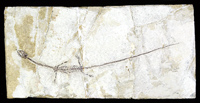 |
Nearly Complete Juvenile 150 Million Year Old Sinohydrosaurus. This 8 inch long juvenile is from the same controversial marine reptile, Sinohydrosaur as the much larger 18 inch adult also in this auction. This juvenile is nearly complete with an excellent skull, as well as three of four feet with even, tiny claws visible. Two huge eye holes are clearly defined in the skull. This specimen is unusual in that it is completely articulated with a complete tail, down to the smallest vertabrae. Weight with display box is 14½ ounces.
Estimated Value $500 - 700.
View details and enlarged photo
| Unsold |
Lot 664 |
 |
Nest of Eight Dinosaur Eggs From Oviraptor, One of the Most Famous and Important Dinosaurs. One of the most desirable of dinosaur eggs belongs to the strange theropod, Oviraptor. The name Oviraptor means egg stealer and when first found near the nest, they were thought to have died trying to eat the eggs. An amazing discovery in 1995 of a near complete Oviraptor actually sitting on a nest made it apparent that the Oviraptor was actually brooding the eggs (picture included with lot). Embryonic bones found in some of these black eggs confirmed that they were Oviraptor young. Oviraptors were about 8 feet long, had a toothless beak and were one of the most bird-like of non-avion theropods.
The museum quality, 8-egg nest comes from the Nanxiang Basin, Guandong Province of China and is about 70 million years old. All of the eggs display their original unhatched shape, as well as 50%-80% of their original black shell with the detail typical of raptor eggs. Oviraptors laid their eggs two at a time; as this partial nest beautifully displays, the eggs were laid two by two in two layers. The 7 inch long eggs reside in their original 18 x 10 inch red sandstone matrix that has been flattened on the bottom for easy display or they can be displayed standing upright.
As no more dinosaur eggs are currently coming out of China, this may be an important opportunity to acquire a museum-quality clutch of eggs. Individual eggs sell for $1,000 or more and nests are much much rarer. Weight is 47 pounds.
Estimated Value $5,000 - 8,500.
View details and enlarged photo
| Realized
$4,140 |
Lot 665 |
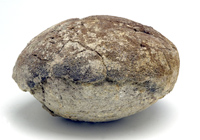 |
Nine Inch Diameter Spherical Dinosaur Egg. One of the most sought after dinosaur eggs, from the bizarre Sauropod, Saltasaurus. They are in great demand due to their large size, nine inches in diameter, and their rarity--only a few dozen are known--and because they are positively identified as belonging to Saltasaurus. This dinosaur was a 36 to 40 foot long sauropod, somewhat like Diplodicus, but with heavy armored scutes covering its neck and back for protection. This 80 to 90 million year old egg was found in the Lecho formation near Salta, Argentina. Bowling-ball sized, uncrushed eggs sell for over $4,000, if you can find one. This very collectable specimen has been lightly crushed by being buried for over 80 million years, but still retains its 3-D circular shape with 70 to 80% of its original shell intact. Where the shell is missing you can see just how thick the shell was, much thicker than any other dino eggs known. Some of these eggs contain embryonic bones which definitely identify them as belonging to the species Saltasaurus. This tannish brown egg would be the highlight of any dinosaur egg collection. Weight is 8 pounds.
Estimated Value $850 - 1,350.
View details and enlarged photo
| Realized
$748 |
Lot 666 |
 |
Opalized BelemniteAnd Bivalve From Australia. The best quality of fire opal comes from the famous Cooper Pedy region of Australia. Occasionally a very few of these 90 million-year-old fossils opalize as part of their fossilization. The 1½ inch long Belemnite, an extinct group of cephalopods related to squids and the chambered nautilus, has been polished to reveal the fine fire opal of reds, greens and blues in a clear milky base. The only part of the extinct Belemnite to fossilize is the torpedo-shaped shell that is contained inside its body and make it rigid for swimming. The opalized belemnite has been placed back in its natural matrix, measuring 3 x 2½ inches. The second fossil is a 1¼ x 1 inch bivalve shell (Modiolus). The calcium carbonate shell has been replaced with fine opal greens and purples, with tinges of orange, and polished to reveal its sparkling beauty. Total weight is 2.8 ounces.
Estimated Value $500 - 900.
View details and enlarged photo
| Unsold |
Lot 667 |
 |
Pair of Dinosaur Coprolites - 15 Million Years Old. This large pair of dinosaur coprolites (doo-doo) consists of a complete 7 lb. coprolite 7 x 6 inches, exactly as found, and a 4 lb., 6 x 3½ inch section that has been cut and polished to show the many different internal colors, somewhat like petrified wood. The pattern of brown, tan, and red occurs as bacteria breaks down the organic compounds which are then replaced by various minerals. This polished piece has a flattened bottom with felt backing, so that it can be used as a paperweight. Only large coprolites can definitely be attributed to dinosaurs, but the exact species of dinosaur cannot be determined. These large coprolites are from the Morrison formation near Garfield, Utah, and were deposited by a large, plant-eating dinosaur, probably a sauropod such as Diplodicus and Comarasaurus, which are commonly found in this area. Total weight is 10 pounds.
Estimated Value $350 - 500.
View details and enlarged photo
| Unsold |
Lot 668 |
 |
Pair of Dinosaur Footprints - 200 Million Years Old. These footprints of two different kinds of early dinosaurs resulted from these dinosaurs walking on a muddy stretch of beach over 200 million years ago near Lincoln Park, New Jersey. These therapods (meat-eating dinosaurs) lived more than 130 million years before T-Rex and were the top predators of their day but much smaller in size. Dinosaurs typically started out small and grew larger over time as the "arms race" between plant eaters and meat eaters intensified. The excellent, well-defined, large theropod footprint measures 8 x 3 inches and even shows the large claw impressions on the ends of the toes. This type of print has the name Grallator cunceatus, although what the dinosaur was who left it is undetermined. Very few dinosaur bones have been found in New Jersey at this time. The fainter, smaller footprint is 4½ x 3 inches from a different species of dinosaur, also unknown. The large Grallator footprint is aesthetically centered on a 17 x 9 inch gray matrix and is a contrasting black in color. Weight is 5½ pounds.
Estimated Value $650 - 950.
View details and enlarged photo
| Realized
$518 |
Lot 669 |
 |
Pair of Spiny Trilobites From Morocco. This rare pair of 400 million year old spiny trilolobites comes from the famous Hamar Laghdad Formation near Alnif, Morocco. What makes this pair so special is that they both have been professionally and carefully uncovered from their stony matrix to display three dimensional spines and give them a life-like appearance. Many many hours of labor are required to achieve these remarkable results, as the stone matrix is extremely hard and literally must be removed a grain at a time.
The larger 2 inch long black trilobite belongs to Ceratarges armatus with its stalked eyes, two long curved spines on the head (Cephalon) and four long curved spines on its tail section (Pygidium). The four front spines, eyestalks and rear spine are free standing. The rest of the spines are complete on the matrix. The second rare trilobite is the 1¾ Leonaspis which has a series of spiked genal spines on the head and body, as well as a "unicorn" type nose, spike spine and stalked eyes. These spines prevented the trilobites from being swallowed whole by predators. The stalked eyes, "unicorn"spikes, and two long genal spines are free standing complete except for the end of one of the spines. These museum-quality trilobites are custom mounted in lucite and were the highlight of an old-time fossil collection. Weight is 4½ pounds.
Estimated Value $1,500 - 2,250.
View details and enlarged photo
| Unsold |
Lot 670 |
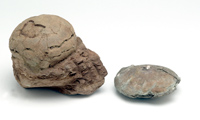 |
Pair of Therizinosaurus Eggs, One With Possible Embryonic Bones. Therizinosaurs were the most bizarre and unusual dinosaurs. They appear to have been a plant-eating theropod related to the raptors. Therizinosaurs walked bipodally with the body, long neck, and small head of a plant-eating dinosaur, but with up to two-feet claws on their hands (artist's conception enclosed). What they used the large claws for is unknown.
Whatever they were, some dinosaur embryos have been found in some of these 3½-4 inch diameter eggs. This lot contains a 4 inch unhatched egg with over 85% of its original shell still in its red limestone matrix, as well as a 3½ inch unhatched crushed egg that has been calcified. The importance of such calcification is that embryonic bones have been found in 5-10% of calcified eggs. The only way to know for sure is to slowly etch the egg to expose any fragile bones present. Both eggs are 65-70 million years old, from the Xixia Basin, Henan Province of China, and are highly displayable, as well as important for study. Total weight is 3 pounds.
Estimated Value $650 - 1,050.
View details and enlarged photo
| Unsold |
Lot 671 |
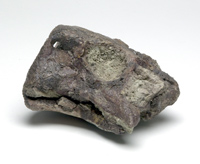 |
An Aquatic Reptile - Ichthyosaurus communis. For those collectors who perfer not to spend many thousands of dollars needed to purchase an entire dinosaur, here is a 7 x 5 in. skull from the very important 127 million year dinosaur, Psittacosaurus (which translates to parrot lizard). It is important because it was the earliest dinosaur to show the beaked face of the ceratopsians, such as its more famous ancestor, Triceratops. One specimen of Psittacosaurus had weird barbs on its tail, somewhat like a porcupine.
This nearly complete brown skull is from the same specimen as the Psittacosaurus hand also offered in this sale. It was found in the famous volcanic layer near Liaoning northern China. Many strange dinosaurs have been excavated in Liaoning, some with feathers. The parrot-like beak, large eyes, fenestrae (which grew in later ceratopsians to become large frills in the back of the skull), and horn-like bones at the ends of its cheeks, all are very clear on this highly desirable specimen.
Estimated Value $1,500 - 1,950.
View details and enlarged photo
| Realized
$863 |
Lot 672 |
 |
"Ram's" Horn Spiny Trilobite From Morocco. One of the most desired of Moroccan trilobites is Dicranurus elegans which is distinctive in having two long curved spines on its head resembling a ram's horn. Four hundred million years ago there were many odd-looking trilobites swimming in the warm seas of Morocco, which now is part of the Sahara desert. This 2½ inch black trilobite has been prepared in its natural state as found crawling over the hard dark gray stone matrix. The all important "ram's" horns have been intricately released from the stone matrix and are free-standing and complete except for the very end of the tip of one of the horns. Weight is 1 pound, 10 ounces.
Estimated Value $350 - 550.
View details and enlarged photo
| Unsold |
Lot 673 |
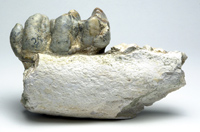 |
Rare Elephant Gomphothere Partial Jaw With 5 Inch Cusped Tooth. The lovely 8 inch long white jaw section is perfectly contrasted with the 5 inch long tooth which has its intact enamel colored shades of brown and gray. Also, the roots of a second tooth are present on the jaw. This rare, museum-quality fossil is 15-20 million years old, from Gansu Province, China. It is from a strange member of the elephant family known as Gomphotheres. Some Gomphotheres had strange shovel-shaped lower tusks used to drag up food. Gomphotheres, as well as Mastodons, had very different types of teeth from all modern elephants. Mastodons and Gomphothere teeth have paired, domed cusps which are placed all along both the upper and lower teeth. This allowed them to chew their food better than modern elephants, which have flat teeth. This specimen makes an impressive display item. Weight is 4 pounds.
Estimated Value $600 - 900.
View details and enlarged photo
| Realized
$518 |
Lot 674 |
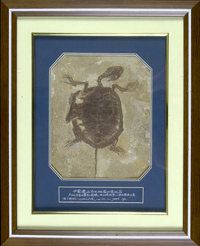 |
Rare Museum-Quality Complete Jurassic Turtle From China. Turtles are not found often as fossils, but when found, only their shell remains. Additionally, most fossil turtles are only 20-30 million years old. This museum quality 7 inch long turtle (Manchurochylus) is both much older--140 million years old--and virtually complete, with all four limbs detailed down to the tiny claws and complete detailed skull. The reason for this extraordinary preservation is that 140 millions ago a volcanic eruption in Liaoning, China buried this turtle under a layer of protective volcanic ash. The brown shell of the turtle has been compressed onto its plastron and lies in a lifelike position on the thin stone volcanic matrix. The turtle is nearly perfect except for a slight shift in the perimeter of the shell on the left side, which is still complete. This remarkable turtle has been professionally mounted and framed for hanging in a 16 x 13 inch brown frame. Weight is 3½ pounds.
Estimated Value $900 - 1,500.
View details and enlarged photo
| Realized
$1,150 |
|
|